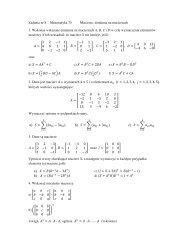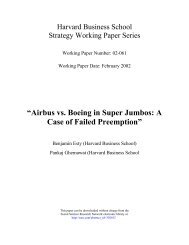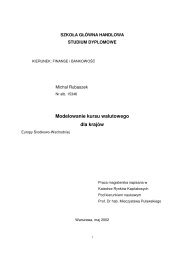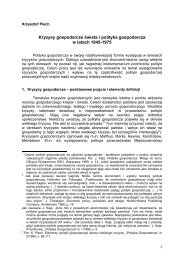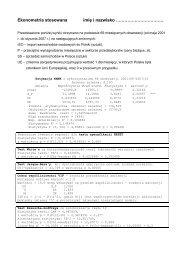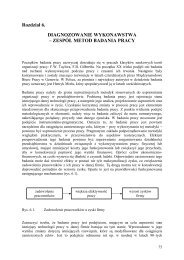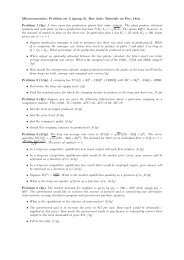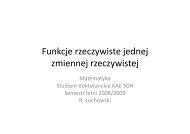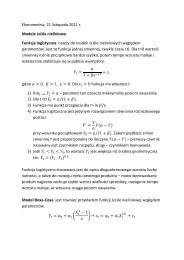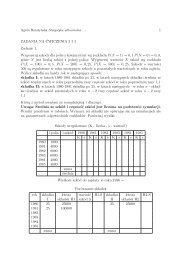Problem sets for Microeconomics II [110051-0471]
Problem sets for Microeconomics II [110051-0471]
Problem sets for Microeconomics II [110051-0471]
You also want an ePaper? Increase the reach of your titles
YUMPU automatically turns print PDFs into web optimized ePapers that Google loves.
<strong>Problem</strong> <strong>sets</strong> <strong>for</strong> <strong>Microeconomics</strong> <strong>II</strong><br />
[<strong>110051</strong>-<strong>0471</strong>]<br />
Spring Semester 2013<br />
Lecture: prof. Jacek Prokop Mon, 13:30-15:10, G - Auditorium B<br />
Seminars: mgr Krzysztof Makowski Mon, 17:10-18:50, G - 105<br />
Office hours: Mon, 16:00-17:00, A - 314<br />
1
1 Optimal decisions using marginal analysis<br />
Exercise 1.1. A television station is considering the sale of promotional videos. It<br />
can have the videos produced by one of two suppliers. Supplier A will charge the<br />
station a setup fee of $1,200 plus $2 <strong>for</strong> each cassette; supplier B has no setup fee<br />
and will charge $4 per cassette. The station estimates its demand <strong>for</strong> the cassettes<br />
to be given by Q = 1, 600 − 200P, where P is the price in dollars and Q is the<br />
number of cassettes.<br />
a. Suppose the station plans to give away the videos. How many cassettes should<br />
it order From which supplier<br />
b. Suppose instead that the station seeks to maximize its profit from sales of the<br />
cassettes. What price should it charge How many cassettes should it order<br />
from which supplier<br />
Exercise 1.2. As the exclusive carrier on a local air route, a regional airline must<br />
determine the number of flights it will provide per week and the fare it will<br />
charge. Taking into account operating and fuel costs, airport charges, and so<br />
on, the estimated cost per flight is $2,000. It expects to fly full flights (100 passengers),<br />
so its marginal cost on a per passenger basis is $20. Finally, the airline’s<br />
estimated demand curve is P = 120 − .1Q, where P is the fare in dollars and Q is<br />
the number of passengers per week.<br />
a. What is the airline’s profit-maximizing fare How many passengers does it<br />
carry per week, using how many flights What is weekly profit<br />
b. Suppose the airline is offered $4,000 per week to haul freight along the route<br />
<strong>for</strong> a local firm. This will mean replacing on of the weekly passenger flights<br />
with a freight flight (at same operating cost). Should the airline carry freight<br />
<strong>for</strong> the local firm Explain.<br />
Exercise 1.3. Under the terms of the current contractual agreement, Burger Queen<br />
(BQ) is entitled to 20 percent of the revenue earned by each of its franchises. BQ’s<br />
best-selling is the Slopper (it slops out of the bun). BQ supplies the ingredients<br />
<strong>for</strong> the Slopper (bun, mystery meat, etc.) at cost to the franchise. The franchisee’s<br />
average cost per Slopper (including ingredients, labor cost, and so on) is $.80. At<br />
a particular franchise restaurant, weekly demand <strong>for</strong> Sloppers is given by P =<br />
3.00 − Q/800.<br />
2
a. If BQ <strong>sets</strong> the price and weekly sales quantity of Sloppers, what quantity and<br />
price should it set How much does BQ receive What is the franchisee’s<br />
net profit<br />
b. Suppose the franchise owner <strong>sets</strong> the price and sales quantity. What price and<br />
quantity will the owner set How does the total profit earned by the two<br />
parties compare to their total profit in part a<br />
c. Now suppose BQ and an individual franchise owner enter into an agreement<br />
in which BQ is entitled to a share of the franchisee’s profit. Will profit<br />
sharing remove the conflict between BQ and the franchise operator Under<br />
profit sharing, what will be the price and quantity of Sloppers (Does<br />
the exact split of the profit affect your answer Explain briefly.) What is the<br />
resulting total profit<br />
d. Profit sharing is not widely practiced in the franchise business. What are the<br />
disadvantages relative to revenue sharing<br />
3
2 Demand analysis and optimal pricing<br />
Exercise 2.1. A private-garage owner has identified two distinct market segments:<br />
short-term parkers and all-day parkers with respective demand curves of P S =<br />
3 − Q S /200 and P C = 2 − Q C /200. Here P is the average hourly rate and Q is the<br />
number of cars parked at this price. The garage owner is considering charging<br />
different prices (on a per-hour basis) <strong>for</strong> short-term parking and all-day parking.<br />
The capacity of the garage is 600 cars, and the cost associated with adding extra<br />
cars in the garage (up to this limit) is negligible.<br />
a. Given this facts, what is the owner’s appropriate objective How can he ensure<br />
that members of each market segment effectively pay a different hourly<br />
price<br />
b. What price should he charge <strong>for</strong> each type of parker How many of each type<br />
of parker will use the garage at these prices Will the garage be full<br />
c. Answer the questions in part b assuming the garage capacity is 400 cars.<br />
Exercise 2.2. A golf-course operator must decide what greens fees (prices) to set<br />
on rounds of golf. Daily demand during week is: P D = 36 − Q D /10 where Q D<br />
is the number of 18-hole rounds and P D is the price per round. Daily demand<br />
on the weekend is P W = 50 − Q W /12. As a practical matter, the capacity of the<br />
course is 240 rounds per day. Wear and tear on the golf course is negligible.<br />
a. Can the operator profit by charging different prices during the week and on<br />
the weekend Explain briefly. What greens fees should the operator set on<br />
weekdays and how many rounds will be played On the weekend<br />
b. When weekend prices skyrocket, some weekend golfers choose to play during<br />
the week instead. The greater the difference between weekday and weekend<br />
prices, the greater are the number of these “defectors”. How might this<br />
factor affect the operator’s pricing policy Give a qualitative answer.<br />
Exercise 2.3. Nearby College Student Recruiting Office has hired a consultant in<br />
an ef<strong>for</strong>t to boost enrollment. After detailed surveys are conducted, the consultant<br />
reports that elasticities are as follows: E P = −1.6, E Y − .8, E X<br />
Competition College tuition). Current tuition at Nearby is $4,000.<br />
= .25 (<strong>for</strong><br />
a. If tuition at Nearby is set to rise by 7%, income is expected to rise by 1%,<br />
and Competition has announced a tuition increase of 6%, how much will<br />
Nearby’s enrollment change<br />
4
. The chief financial officer approaches the Recruiting officer, and asks <strong>for</strong> a<br />
copy of the report. He says that he would like to see a tuition change because<br />
the school is facing a budget crunch. If the marginal cost of a student<br />
is $2,750, what should tuition be in order to maximize profit<br />
Exercise 2.4. Jonathan Livingstone Yuppie is a prosperous lawyer. Jonathan consumes<br />
three goods, unblended Scotch whiskey ($20 per bottle), designer tennis<br />
shoes ($80 per pair), and meals in French gourmet restaurants ($50 per meal).<br />
After he has paid his taxes and alimony, Jonathan has $400 a week to spend.<br />
a. Write down a budget equation.<br />
b. Draw a three-dimensional diagram to show his budget set.<br />
c. Suppose that he determines that he will buy one pair of designer tennis shoes<br />
per week.<br />
What equation must be satisfied by the combinations of the<br />
restaurant meals and whiskey that he could af<strong>for</strong>d<br />
Exercise 2.5. Nancy Lerner is trying to decide how to allocate her time in studying<br />
<strong>for</strong> her economics course. There are two examinations in this course. Her overall<br />
score <strong>for</strong> the course will be minimum of her scores on the two examinations. She<br />
has decided to devote a total of 1,200 minutes to studying <strong>for</strong> these two exams,<br />
and she wants to get as high overall score as possible. She knows that on the first<br />
examination if she doesn’t study at all, she will get a zero score on it. For every 10<br />
minutes that she spends studying <strong>for</strong> the first examination, she will increase her<br />
score by one point. if she doesn’t study at all <strong>for</strong> the second examination, she will<br />
get a zero score on it. For every 20 minutes she spends studying <strong>for</strong> the second<br />
examination, she will increase her score by one point.<br />
Determine the optimal allocation of the time spent on studying <strong>for</strong> the examinations.<br />
Show it on the graph.<br />
Exercise 2.6. The utility maximizing consumer has his preferences over goods<br />
x 1 and x 2 described by Cobb-Douglas utility function u(x 1 , x 2 ) = x a 1 x1−a 2<br />
, where<br />
a = 1/3.<br />
a. Find the marginal rate of substitution of good x 1 with good x 2 .<br />
b. Suppose that consumer’s disposable income is m = 20, the price of good x 1 is<br />
p 1 = 5, and the price of good x 2 is p 2 = 4. What is the amount of good x 2<br />
that consumer is willing to consume (Both goods are infinitely divisible).<br />
5
3 Production and cost analysis<br />
Exercise 3.1. Suppose that production function of the steelworks is given by Q =<br />
5LK, where L is the number of workers, and K is the amount of capital used to<br />
give Q units of steel daily. Steelwork can hire labor at $10 per unit, and the cost<br />
of capital is $20 per unit.<br />
What is the optimal mix of inputs to produce 40 units of steel<br />
Exercise 3.2. The owner of the “Magic car wash” describes the relation between<br />
number of cars washed and labor input as follows: Q = −.8 + 4.5L − .3L 2 , where<br />
Q is the number of cars washed per hour, and L is the number of employees. For<br />
each car washed the owner gets $5, and he pays $4.5 per hour to his employees.<br />
a. How many persons should the owner employ to maximize profit<br />
b. What is the profit per hour<br />
c. Is the above labor to cars washed relation true <strong>for</strong> all L Explain.<br />
Exercise 3.3. Firm Z is developing a new product. An early introduction (beating<br />
rivals to market) would greatly enhance the company’s revenues. However, the<br />
intensive development ef<strong>for</strong>t needed to expedite the introduction can be very<br />
expensive. Suppose total revenues and costs associated with the new product’s<br />
introduction are given by R = 720 − 8t and C = 600 − 20t + .25t 2 , where t is the<br />
introduction date (in months from now).<br />
a. Some executives have argued <strong>for</strong> an expedited introduction date 12 months<br />
from now (t = 12). Do you agree<br />
b. How about instant introduction (t = 0) What introduction date is most profitable<br />
Explain.<br />
Exercise 3.4. In a particular region, there are two lakes rich in fish. The quantity<br />
of fish caught in each lake depends on the number of persons who fish in each,<br />
according to Q 1 = 10N 1 − .1N1 2 and Q 2 = 16N 2 − .4N2 2, where N 1 and N 2 denote<br />
the number of fishers at each lake. In all, there are 40 fishers.<br />
a. Suppose N 1 = 16 and N 2 = 24. At which lake is the average catch per fisher<br />
greater In light of this fact, how would you expect the fishers to redeploy<br />
themselves<br />
6
. How many fishers will settle at each lake<br />
c. The commissioner of fisheries seeks a division of fisheries that will maximize<br />
the total catch at the two lakes. What division of the 40 fisheries would you<br />
recommend<br />
Exercise 3.5. Let Q = L α K β . Suppose the firm seeks to produce a given output<br />
while minimizing its total input cost: C = P L L + P K K.<br />
Show that the optimal quantities of labor and capital satisfy L/K = (α/β) (P K /P L ).<br />
Provide an intuitive explanation <strong>for</strong> this result.<br />
Exercise 3.6. Henry is serving lemonade on the corner of the busy street of Philadelphia.<br />
His production function is f (x 1 , x 2 ) = x 1/3<br />
1<br />
x 1/3<br />
2<br />
, where product is measured<br />
in liters, x 1 is the amount of lemons in kilograms, and x 2 is the number of<br />
hours spent on squeezing lemons.<br />
a. What are the returns to scale of the above production function<br />
b. If w 1 is the price of one kilogram of lemons, and w 2 is the hourly wage of<br />
lemon-squeezer, the optimal working method is to work <strong>for</strong> ............ hours<br />
per one kilogram of lemons.<br />
c. Given that Henry produced y liters of lemonade, he used ............ kilograms of<br />
lemons and worked <strong>for</strong> ............ hours.<br />
Exercise 3.7. The production function is f (x 1 , x 2 ) = min {x 1 , x 2 }.<br />
a. Suppose x 1 < x 2 . The marginal product of x 1 is ..........., and with small increase<br />
in the amount of x 1 (increases, decreases, remains constant) ........... .<br />
The<br />
marginal product of x 2 is ..........., and with small increase in the amount of<br />
x 2 (increases, decreases, remains constant) ........... .<br />
substitution between x 2 and x 1 is ............ .<br />
(increasing, constant, decreasing) ............ returns to scale.<br />
The technical rate of<br />
This technology demonstrates<br />
b. Let x 1 = x 2 . What is the marginal product of x 1 with small increase in the<br />
amount of x 1 What is the marginal product of x 1 with small increase in<br />
the amount of x 2 The marginal product of x 1 with small increase in the<br />
amount of x 2 (increases, decreases, remains constant) ............ .<br />
Exercise 3.8. A manufacturing firm decided to build a factory. Choice is to be<br />
made between two types. Type A is characterized by following short-term production<br />
costs: C A = 80 + 2Q A + .5Q 2 A ; while type B: C B = 50 + Q 2 B .<br />
7
a. If eight units of the product are to be manufactured, which type of the factory<br />
should be chosen How many units need to be produced to justify building<br />
type A factory<br />
b. Suppose the manufacturing company owns two factories (one of each type).<br />
If the total production is big enough it is optimal to maintain production in<br />
both factories. Explain why. Let us assume that planned production is 22<br />
units. How the production should be divided between factories to minimize<br />
cost of production<br />
Exercise 3.9. A multinational firm produces steel at a home facility and at a <strong>for</strong>eign<br />
subsidiary. The demand <strong>for</strong> the product is different at home and abroad.<br />
Furthermore, the production costs are different at both facilities. The home demand<br />
is P H = 260 − .1Q H , and <strong>for</strong>eign is P F = 240. The respective cost curves<br />
are: C H = 1, 000 + .4Q 2 H , and C F = 5, 000 + .25Q 2 F .<br />
a. Due to taxes or import quotas your products are not shipped overseas. Find<br />
firm’s profit-maximizing outputs, sales quantities and prices <strong>for</strong> both home<br />
and <strong>for</strong>eign market.<br />
b. Suppose that the fiscal constraints are lifted. (Shipment cost is negligible).<br />
Answer the questions in a. once again.<br />
c. Suppose the shipment cost is $16 per ton. Answer the questions in a. once<br />
again.<br />
Exercise 3.10. A firm produces according to the following production function:<br />
Q = K 1/4 L 3/4 , where Q - units of output, K - units of capital, and L - units of<br />
labor. Suppose that the price of K is $4 per unit, and the price of L is $6 per unit.<br />
What is the optimal capital/labor ratio<br />
Exercise 3.11. Ranger construction is preparing to repair potholes, under contract<br />
to the local county road repair agency. Based on past experience, Ranger has<br />
found that output can be described by: Q = K 1/2 L 1/2 , where Q - pot holes filled,<br />
K - units of capital, and L - units of labor. Ranger can hire labor at $12 per unit,<br />
and the cost of capital is $8 per unit. Capacity limitations require that Ranger<br />
accept no more than $96,000 worth of filling this season.<br />
a. What is the optimal mix of inputs <strong>for</strong> Ranger<br />
b. How many potholes should Ranger agree to fill<br />
8
Exercise 3.12. Flo is a university administrator. She has found that happy plants<br />
only need fertilizer and talk. Where f is the number of bags of fertilizer used<br />
and t is the number of hours she talk to her plants, the number of happy plants<br />
produced is exactly h = t + 2 f . Suppose fertilizer costs w f per bag and talk costs<br />
w t per hour.<br />
a. If w t < w f /2, would it be cheaper <strong>for</strong> Flo to use fertilizer or talk to raise one<br />
happy plant<br />
b. Flo’s cost function is c ( w f , w t , h ) =............ .<br />
c. Flo’s factor demand <strong>for</strong> talk is t ( w f , w t , h ) = ............ .<br />
Exercise 3.13. Henry is a wealthy entrepreneur, who owns a tropical juice factory.<br />
Its production function is given by F (K, L) = K 2/3 L 1/4 , where K and L are<br />
respectively capital and labor inputs. The price of capital is r, and the cost of labor<br />
is w.<br />
a. Show the production function on the graph (use isoquants).<br />
b. What returns to scale demonstrates the technology used<br />
c. Henry is minimizing costs in his factory and he wants to produce Y units of<br />
juice. Find Henry’s demand <strong>for</strong> capital<br />
9
4 Decision making under uncertainty and value of<br />
in<strong>for</strong>mation<br />
Exercise 4.1. In 1976, the parents of a 7-year-old boy sued a New York hospital <strong>for</strong><br />
$3.5 million. The boy was blinded shortly after he was born two weeks prematurely.<br />
His parents claimed that hospital doctors administered excessive oxygen<br />
to the baby and that caused the blindness. The case went to trial, and just as the<br />
jury announced it hat reached the verdict, the lawyers <strong>for</strong> the two sides arrived<br />
at an out-of-court settlement of $500,000.<br />
a. If you were the parents, how would you decide whether to accept the settlement<br />
or wait <strong>for</strong> the jury’s decision What probability assessments would<br />
you need to make Would you have accepted the settlement<br />
b. Answer the questions in part a, taking the hospital’s point of view.<br />
Exercise 4.2. A European consortium has spent a considerable amount of time<br />
and money developing a new supersonic aircraft. The aircraft gets high marks on<br />
all per<strong>for</strong>mance measures except noise. In fact, because of the noise, the consortium’s<br />
management is concerned that the U.S. government may impose restrictions<br />
at some of the American airports where the aircraft can land. Management<br />
judges a 50-50 chance that there will be some restrictions. Without restrictions,<br />
management estimates its (present discounted) profit at $125 million; with restrictions,<br />
its profit would be only $25 million. Management must decide now,<br />
be<strong>for</strong>e knowing the government’s decision, whether to redesign parts of the aircraft<br />
to solve the noise problem. The cost of the redesign program is $25 million.<br />
There is a .6 chance that the redesign program will solve the noise problem (in<br />
which case, full landing rights are a certainty) and a .4 chance it will fail.<br />
a. Using decision tree , determine the consortium’s best course of action, assuming<br />
management is risk neutral.<br />
b. Find the expected value of perfect in<strong>for</strong>mation about the redesign program.<br />
Calculate separately the expected value of perfect in<strong>for</strong>mation about the<br />
U.S. government’s decision.<br />
c. Suppose the management of the consortium questions its engineers about the<br />
success or failure of the redesign program prior to committing to it. Management<br />
recognizes that its engineers are likely to be biased in favor of the<br />
program. It judges that if the program truly will succeed, the engineers will<br />
10
endorse it 90 percent of the time, but even if the program will fail, they will<br />
endorse it 50 percent of the time. What is the likelihood of success in light<br />
of an endorsement What if the engineers do not endorse the program<br />
Exercise 4.3. Firm A is facing a possible lawsuit by legal firm B. Firm B represents<br />
the family of Mr. Smith, who was killed in a motel fire (allegedly caused by faulty<br />
wiring). Firm A was the builder of the motel. Firm A has asked its legal team<br />
to estimate the likely jury award it will be ordered to pay in court. Expert legal<br />
counsel anticipates three possible court outcomes: awards of $1,000,000, $600,000,<br />
or $0, with probabilities .2, .5, and .3, respectively. In addition to any awards,<br />
firm A’s legal expenses associated with fighting the court case are estimated to be<br />
$100,000. Firm A also has considered the alternative of entering out-of-court settlement<br />
negotiations with firm B. Based on the assessments of its lawyers, firm A<br />
envisions the other side holding out <strong>for</strong> one of two settlement amounts: $900,000<br />
(a high amount) or $400,000 (a more reasonable amount). Each demand is considered<br />
equally likely. If presented with one of these settlement demands, firm A<br />
is free to accept it (in which case firm B agrees to waive any future right to sue)<br />
or reject it and take its chances in court. The legal cost of pursuing a settlement<br />
(whether or not one is reached) is $50,000.<br />
Determine the settlement or litigation strategy that minimizes firm A’s expected<br />
total cost (any payment plus legal fees).<br />
Exercise 4.4. Consider the following simplified version of the television game<br />
show Let’s Make a Deal. There is a grand prize behind one of three curtains;<br />
the other two curtains are empty. As a contestant, you get to choose a curtain<br />
at random. Let’s say you choose curtain 3. Be<strong>for</strong>e revealing what’s behind the<br />
curtain, the game show host always offers to show you what one of the other<br />
curtains contains. She shows you that curtain 2 is empty; in fact, she always<br />
shows you an empty curtain. (You know that’s how the game works; so does the<br />
audience and everybody else.)<br />
Now you must decide: Do you stick with your original choice, curtain 3, or<br />
switch to curtain 1 Which action gives you the better chance of finding the grand<br />
prize<br />
Exercise 4.5. Filene’s Basement, a Boston-based department store, has a policy of<br />
marking down the price of sale items each week that they go unsold. You covet<br />
an expensive brand of winter coat that is on sale <strong>for</strong> $100. In fact, you would be<br />
willing to pay as much as $120 <strong>for</strong> it. Thus, you can buy it now (<strong>for</strong> a profit of<br />
11
$120 - $100 = $20) or wait until next week, when the price will be reduced to $75<br />
if the coat is still available. The chances of its being available next week are 2/3.<br />
If it is available in week 2, you can buy or wait until week 3. There is a 1/2 chance<br />
it will be sold between weeks 2 and 3 and a a 1/2 chance it will be available at a<br />
reduced price of $60. Finally, if it is available in week 3, you can buy or wait until<br />
week 4. There is a 1/4 chance it still will be available, at a price of $50 (and a 3/4<br />
chance it will be sold in the meantime). Week 4 is your last chance to buy be<strong>for</strong>e<br />
the coat is withdrawn.<br />
a. How long should you wait be<strong>for</strong>e buying Illustrate via a decision tree.<br />
b. Filene’s has 120 of these winter coats <strong>for</strong> sale. What is expected total revenue<br />
from the pricing scheme in part a<br />
c. Alternatively, Filene’s can set a single price <strong>for</strong> all coats. Its demand curve<br />
is P = 180 − Q. Would it prefer a common-price method or the pricereduction<br />
method in part b Explain.<br />
12
5 Perfect competition and monopoly<br />
Exercise 5.1. In a competitive market, the industry demand and supply curves<br />
are P = 200 − .2Q D and P = 100 + .3Q S , respectively.<br />
a. Find the market’s equilibrium price and output.<br />
b. Suppose the government imposes a tax of $20 per unit of output on all firms<br />
in the industry. What effect does this have on the industry supply curve<br />
Find the new competitive price and output. What portion of the tax has<br />
been passed on to consumers via a higher price<br />
c. Suppose a $20-per-unit sales tax is imposed on consumers. What effect does<br />
this have on the industry demand curve Find the new competitive price<br />
and output. Compare this answer to your findings in part b.<br />
Exercise 5.2. Firm Z, operating in a perfectly competitive market, can sell as much<br />
or as little as it wants of a good at a price of $16 per unit. Its total cost function<br />
is TC = 50 + 4Q + 2Q 2 . The associated marginal cost is MC = 4 + 4Q and the<br />
point of minimum average cost is Q min = 5.<br />
a. Determine the firm’s profit-maximizing level of output. Compute its profit.<br />
b. The industry demand curve is Q = 200 − 5P. What is the total market demand<br />
at the current $16 price If all firms in the industry have cost structures<br />
identical to that of firm Z, how many firms will supply the market<br />
c. The outcomes in part a and b cannot persist in the long run. Explain why. Find<br />
the market’s price, total output per firm in the long run.<br />
d. Comparing the short-run and long-run results, explain changes in the price<br />
and in the number of firms.<br />
Exercise 5.3. In a competitive market, the industry demand and supply curves<br />
are P = 70 − Q D and P = 40 + 2Q S .<br />
a. Find the market’s equilibrium price and output.<br />
b. Suppose that the government provides a subsidy to producers of $15 per unit<br />
of the good. Since the subsidy reduces each supplier’s marginal cost by<br />
15, the new supply curve is P = 25 + 2Q S . Find the market’s new equilibrium<br />
price and output. Provide an explanation <strong>for</strong> the change in price and<br />
quantity.<br />
13
c. A public interest group supports the subsidy, arguing that it helps consumers<br />
and producers alike. Economists oppose the subsidy, declaring that it leads<br />
to an inefficient level of output. In your opinion, which side is correct<br />
Explain carefully.<br />
Exercise 5.4. Until recently, the market <strong>for</strong> air travel within Europe was highly<br />
regulated. Entry of new airlines was severely restricted, and air fares were set<br />
by regulation. Partly as a result, European air fares were and continue to be<br />
higher than U.S. fares <strong>for</strong> routes of comparable distance. Suppose that, <strong>for</strong> a given<br />
European air route (say, London to Rome), annual air travel demand is estimated<br />
to be Q = 1, 500 − 3P, where Q is the number of trips in thousands and P is<br />
the one-way fare in dollars. In addition, the long-run average (one-way) cost per<br />
passenger along this route is estimated to be $200.<br />
a. Some economists have suggested that during the 1980s and 1990s there was<br />
an implicit cartel among European air carriers whereby the airlines charged<br />
monopoly fares under the shield of regulation. Given the preceding facts,<br />
find the profit-maximizing fare and the annual number of passenger trips.<br />
b. In the last five years, deregulation has been the norm in the European market,<br />
and this has spurred new entry and competition from discount air carriers<br />
such as Ryanair and easyJet. Find the price and quantity <strong>for</strong> the European<br />
air rout if perfect competition became the norm.<br />
Exercise 5.5. Demand <strong>for</strong> microprocessors is given by P = 35 − 5Q, where Q is<br />
the quantity of microchips (in millions). The typical firm’s total cost of producing<br />
a chip is C i = 5q i , where q i is the output of firm i.<br />
a. Under perfect competition, what are the equilibrium price and quantity<br />
b. Under perfect competition, find total industry profit and consumer surplus.<br />
c. Suppose that one company acquires all the suppliers in the industry and thereby<br />
creates a monopoly. What are the monopolist’s profit-maximizing price and<br />
total output<br />
d. Compute the monopolist’s profit and the total consumer surplus of purchasers.<br />
e. Discuss changes between your answers in parts b. and d.<br />
Exercise 5.6. Suppose that, over the short run (say, the next five years), demand<br />
<strong>for</strong> OPEC oil is given by Q = 52.5 − 1.25P. (Here Q is measured in millions of<br />
barrels per day.) OPEC’s marginal cost per barrel is $10.<br />
14
a. What is OPEC’s optimal level of production What is the prevailing price of<br />
oil at this level<br />
b. Many experts contend that maximizing short-run profit is counterproductive<br />
<strong>for</strong> OPEC in the long run because high prices induce buyers to conserve<br />
energy and seek supplies elsewhere. Suppose the demand curve just described<br />
will remain unchanged only if oil prices stabilize at $20 per barrel or<br />
below. If oil price exceeds this threshold, long-run demand (over a second<br />
five-year period) will be curtailed to Q = 60 − 2P. OPEC seeks to maximize<br />
its total profit over the next decade. What is its optimal output and price<br />
policy (Assume all values are present values.)<br />
Exercise 5.7. Firm 1 is a member of a monopolistically competitive market. Its<br />
total cost function is C = 900 + 60Q 1 + 9Q 2 1<br />
. The demand curve <strong>for</strong> the firm’s<br />
differentiated product is given by P = 660 − 16Q 1 .<br />
a. Determine the firm’s profit maximizing output, price and profit.<br />
b. Attracted by potential profits, new firms enter the market. A typical firm’s<br />
demand curve (say firm’s 1) is given by P = [1, 224–16(Q 2 + Q 3 + ... +<br />
Q N )–16Q 1 ], where N is the total number of firms.<br />
(If competitors’ outputs<br />
or numbers increase, firm 1’s demand curve shifts inward.) The longrun<br />
equilibrium under monopolistic competition is claimed to consist of 10<br />
firms, each producing 6 units at a price of $264. Is this claim correct<br />
c. Based on the cost function given, what would be the outcome if the market<br />
were perfectly competitive (Presume market demand is P = 1, 224 − 16Q,<br />
where Q is total output.) Compare this outcome to the outcome in part b.<br />
Exercise 5.8. A single buyer who wields monopoly power in its purchase of an<br />
item is called a monopsonist. Suppose that a large firm is the sole buyer of parts<br />
from 10 small suppliers. The cost of a typical supplier is given by C = 20 + 4Q +<br />
Q 2 .<br />
a. Suppose that the large firm <strong>sets</strong> the market price at some level P. Each supplier<br />
acts competitively (i.e., <strong>sets</strong> output to maximize profit given P). What is the<br />
supply curve of the typical supplier Of the industry<br />
b. The monopsonist values the part at $10. This is the firm’s break-even price, but<br />
intends to offer a price much less than this and purchase all parts offered. If<br />
it <strong>sets</strong> price P, its profit is simply: π = (10 − P)Q S , where Q S is the industry<br />
15
supply curve found in part a. (Of course, Q S is a function of P.) Write down<br />
the profit expression and maximize profit with respect to P. Find the firm’s<br />
optimal price. Give a brief explanation <strong>for</strong> this price.<br />
16
6 Oligopolistic competition<br />
Exercise 6.1. The OPEC cartel is trying to determine the total amount of oil to sell<br />
on the world market. It estimates world demand <strong>for</strong> oil to be Q W = 60 − .5P,<br />
Q W denotes the quantity of oil (in millions of barrels per day) and P is price per<br />
barrel. The cartel’s marginal cost is approximately $20 per barrel.<br />
a. Determine OPEC’s profit-maximizing output and price.<br />
b. OPEC’s economists recognize the importance of non-OPEC oil supplies. These<br />
can be described by the estimated supply curve Q S = 1.5P − 20. Write<br />
OPEC’s net demand curve. Find its optimal output and price. What portion<br />
of the world’s total oil supply comes from OPEC<br />
Exercise 6.2. Firm A is the dominant firm in a market where industry demand<br />
is given by Q D = 48 − 4P. There are four “follower” firms, each with long-run<br />
marginal cost given by MC = 6 + Q F . Firm A’s long run marginal cost is 6.<br />
a. Write the expression <strong>for</strong> the total supply curve of the followers (Q S ) as this<br />
depends on price.<br />
b. Find the net demand curve facing firm A. Determine A’s optimal price and<br />
output. How much output do the other firms supply in total<br />
Exercise 6.3. In the small town there are two confectioneries: one of the Mr Long<br />
and one of the Mr Short. Nobody can tell the cakes from those confectioneries<br />
apart. The marginal costs of Mr Long are constant - $1 per cake. Mr Short has<br />
constant marginal costs of $2 per cake. There are no fixed costs. The inverse<br />
demand function is p(q) = 6–.01q , where q is the sum of the cakes sold by both<br />
confectionery owners.<br />
a. Find the reaction functions, quantities and profits in the equilibrium, assuming<br />
that confectionery owners competition is of Cournot type.<br />
b. Find the quantities and profits in the equilibrium, assuming that confectionery<br />
owners competition is of Bertrand type.<br />
c. Assume that Mr Long is a leader of Stackelberg type competition (Probably<br />
due to fact, that he starts working an hour earlier than Mr Short.) Find the<br />
quantities and profits in the equilibrium.<br />
17
7 Game theory<br />
Exercise 7.1. Firms M and N compete <strong>for</strong> a market and must independently decide<br />
how much to advertise. Each can spend either $10 million or $20 million on<br />
advertising. If the firms spend equal amounts, they split the $120 million market<br />
equally. (For instance, if both choose to spend $20 million, each firm’s net profit<br />
is 60 – 20 = $40 million.) If one firm spends $20 million and other $10 million, the<br />
<strong>for</strong>mer claims two thirds of the market and the latter one-third.<br />
a. If the firms act independently, what advertising level should each choose Explain.<br />
Is a prisoner’s dilemma present<br />
b. Could the firms profit by entering into an industry-wide agreement concerning<br />
the extent of advertising Explain.<br />
Exercise 7.2. A firm sells two goods in a market consisting of three types of consumers.<br />
The table shows the values consumers place on the goods. The unit cost<br />
of producing each good is $5.<br />
Good<br />
Consumers X Y<br />
A 13 6<br />
B 7 11<br />
C 15 2<br />
Find the optimal prices <strong>for</strong> (a) selling the goods separately, (b) pure bundling,<br />
and (c) mixed bundling. Which pricing strategy is most profitable<br />
Exercise 7.3. Find all Nash equilibriums in the game of two banks, whose management<br />
considers selling to debtors their liabilities <strong>for</strong> the discounted price.<br />
Bank <strong>II</strong><br />
S<br />
NS<br />
Bank I S 6,6 6,11<br />
NS 11,6 6,6<br />
Exercise 7.4. There are three payoff tables given.<br />
a. Identify the equilibrium outcome(s) in each of the three payoff tables.<br />
I. C 1 C 2<br />
R 1 12,10 10,4<br />
R 2 4,8 9,6<br />
<strong>II</strong>. C 1 C 2<br />
R 1 12,10 4,4<br />
R 2 4,4 9,6<br />
18<br />
<strong>II</strong>I. C 1 C 2<br />
R 1 12,10 4,4<br />
R 2 4,-100 9,6
. In each table, predict the exact outcome that will occur and explain your reasoning<br />
c. In table <strong>II</strong>I, suppose the column player is worried that the row player might<br />
choose R 2 (perhaps a one-in-ten chance). Given the risk, how should the<br />
column player act Anticipating the column player’s thinking, how should<br />
the row player act<br />
Exercise 7.5. Two firms dominate the market <strong>for</strong> surgical sutures and compete<br />
aggressively with respect to research and development. The following payoff<br />
table depicts the profit implications of their different R&D strategies.<br />
a. Suppose that no communication is possible between the firms; each must choose<br />
its R&D strategy independently of the other. What actions will the firms<br />
take, and what is the outcome<br />
b. If the firms can communicate be<strong>for</strong>e setting their R&D strategies, what outcome<br />
will occur Explain.<br />
Firm B’s R&D Spending<br />
Low Medium High<br />
Firm A’s R&D Spending Low 8,11 6,12 4,14<br />
Medium 12,9 8,10 6,8<br />
High 11,6 10,8 4,6<br />
Exercise 7.6. One way to lower the rate of auto accidents is strict en<strong>for</strong>cement of<br />
motor vehicle laws (speeding, drunk driving, and so on). However, maximum<br />
en<strong>for</strong>cement is very costly. The following payoff table lists payoffs of a typical<br />
motorist and a town government. The motorist can obey or disobey motor vehicle<br />
laws, which the town can en<strong>for</strong>ce or not.<br />
Town<br />
En<strong>for</strong>ce Don’t En<strong>for</strong>ce<br />
Motorist Obey 0,-15 0,0<br />
Don’t Obey -20,-20 5,-10<br />
a. What is the town’s optimal strategy What is the typical motorist’s behavior<br />
in response<br />
b. What if the town could commit to a strict en<strong>for</strong>cement policy and motorists<br />
believed that this policy would be used Would the town wish to do so<br />
19
c. Now suppose the town could commit to en<strong>for</strong>cing the law part of the time.<br />
(The typical motorist cannot predict exactly when the town’s traffic police<br />
will be monitoring the roadways.) What is the town’s optimal degree (i.e.,<br />
percentage) of en<strong>for</strong>cement Explain.<br />
Exercise 7.7. In the following game, players A and B alternate moves. At each<br />
turn, a player can terminate the game or pass move to the next player. By passing,<br />
the player increases the rival’s potential payoff by five units and reduces her own<br />
by one unit. Thus, as long as both players pass the move on to one another, their<br />
payoffs increase. If the game terminates immediately - the payoff is (2,2). Player<br />
A starts the game.<br />
a. Draw a game tree <strong>for</strong> this extensive <strong>for</strong>m game.<br />
b. Suppose you are paired with another student with whom you will play the<br />
game. Just based on your judgment (no analysis), how would you play<br />
c. Now analyze the game tree by working backward. What actions should the<br />
players take What is the outcome Briefly explain this result.<br />
d. The experiments with the above described game show that many of the players<br />
A decides to pass the move. How could you explain this result<br />
Exercise 7.8. Over the last decade, the Delta Shuttle and the U.S. Air Shuttle have<br />
battled <strong>for</strong> market share on the Boston – New York and Washington, DC – New<br />
York routes. In addition to service quality and dependability (claimed or real),<br />
the airlines compete on price via periodic fare changes. The hypothetical payoff<br />
table lists each airline’s estimated profit (expressed on a per-seat basis) <strong>for</strong> various<br />
combinations of one-way fares.<br />
U.S. Air Shuttle<br />
$139 $119 $99<br />
Delta Shuttle $139 34,38 15,42 6,32<br />
$119 42,20 22,22 10,25<br />
$99 35,7 27,9 18,16<br />
a. Suppose that the two airlines select their fares independently and “once and<br />
<strong>for</strong> all.” (The airlines’ fares cannot be changed.) What fares should the airlines<br />
set<br />
20
. Suppose, instead, that the airlines will set fares over the next 18 months. In<br />
any month, each airline is free to change its fare if it wishes. What pattern<br />
of fares would you predict <strong>for</strong> the airlines over the 18 months<br />
c. Pair yourself with another student <strong>for</strong>m the class. The two of you will play<br />
the roles of Delta and U.S. Air and set prices <strong>for</strong> the next 18 months. You<br />
will exchange written prices <strong>for</strong> each month. You then can determine your<br />
profit (and your partner’s profit) from the payoff table. The competition<br />
continues in this way <strong>for</strong> 18 months, after which time you should compute<br />
your total profit (the sum of your monthly payoffs). Summarize the results<br />
of your competition. What lessons can you draw from it<br />
21


![Problem sets for Microeconomics II [110051-0471]](https://img.yumpu.com/32645692/1/500x640/problem-sets-for-microeconomics-ii-110051-0471.jpg)

